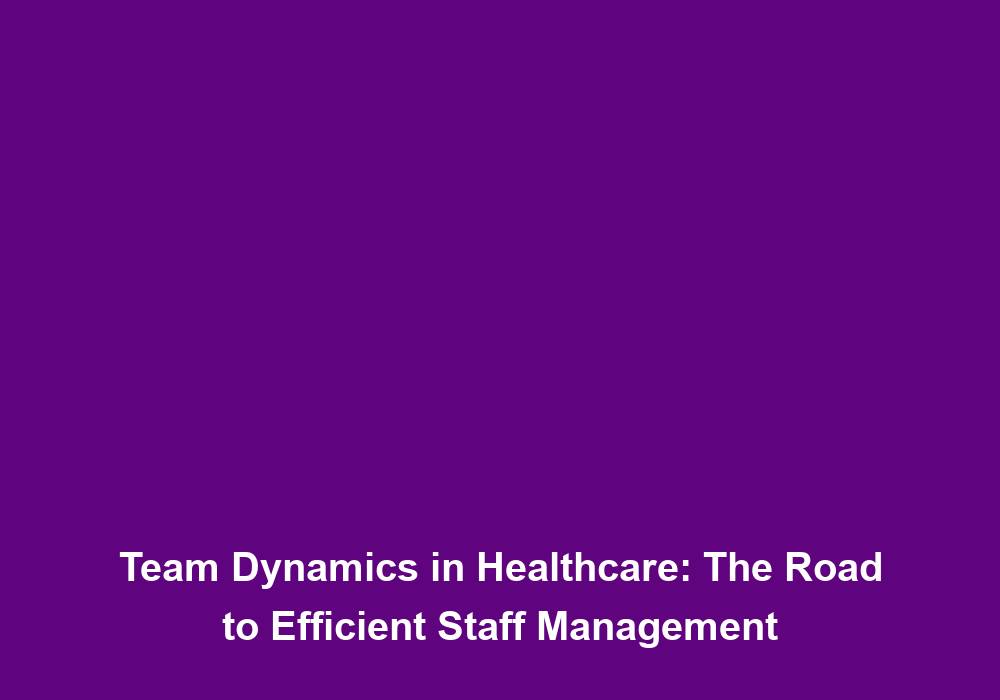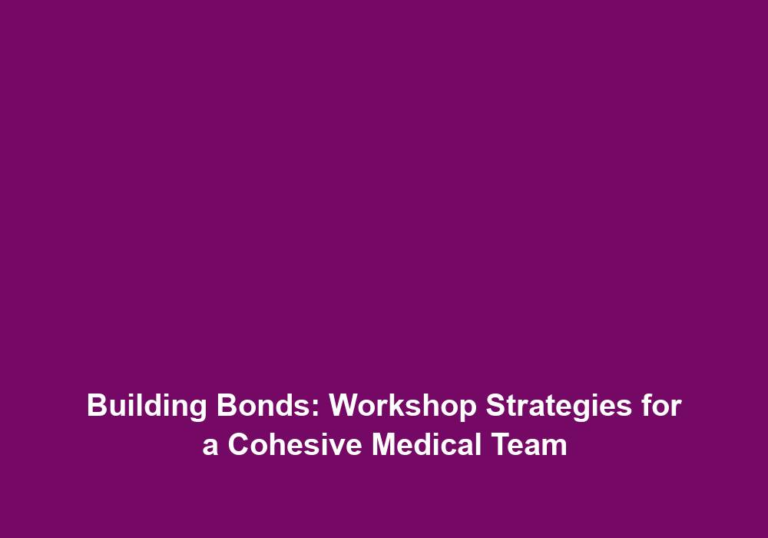Team Dynamics in Healthcare: The Road to Efficient Staff Management
In the fast-paced and demanding field of healthcare, effective team dynamics play a crucial role in ensuring efficient staff management. The ability of healthcare professionals to collaborate, communicate, and work cohesively can greatly impact patient outcomes, staff satisfaction, and overall organizational success. This article delves into the importance of team dynamics in healthcare and explores strategies for fostering a positive and effective team environment.
Why are Team Dynamics Important in Healthcare?
- Improved Patient Care: Effective team dynamics contribute to improved patient care by promoting clear communication, seamless cooperation, and the sharing of expertise among healthcare professionals. When team members work harmoniously, they can deliver coordinated and comprehensive care, leading to positive patient outcomes.
Efficient team dynamics enable healthcare professionals to communicate effectively with each other, ensuring that critical information is shared accurately and promptly. This clear communication helps prevent misunderstandings, reduces medical errors, and improves patient safety. Additionally, seamless cooperation among team members allows for efficient coordination of tasks and the sharing of expertise. By leveraging the collective knowledge and skills of the team, healthcare professionals can provide comprehensive care that addresses all aspects of a patient’s needs, leading to better health outcomes.
- Enhanced Staff Satisfaction: A positive team dynamic fosters a supportive work environment, where team members feel valued, respected, and empowered. This, in turn, leads to increased staff satisfaction, motivation, and overall job fulfillment. When healthcare professionals are satisfied with their work environment, they are more likely to provide high-quality care and remain committed to their organization.
In a positive team dynamic, healthcare professionals experience a sense of belonging and camaraderie. They feel supported by their colleagues, which boosts their confidence and job satisfaction. This supportive environment also encourages open communication, allowing team members to share their ideas, concerns, and feedback. As a result, healthcare professionals feel heard and valued, fostering a strong sense of empowerment. This sense of fulfillment and satisfaction translates into their work, leading to increased motivation and dedication to providing excellent patient care.
- Efficient Resource Utilization: In a well-functioning team, roles and responsibilities are clearly defined, allowing for effective resource allocation. Each team member brings unique skills and expertise to the table, enabling the efficient utilization of available resources, such as time, equipment, and personnel. This helps optimize workflow and maximize productivity within healthcare settings.
Clear definition of roles and responsibilities ensures that tasks are assigned to the most suitable team member, considering their expertise and capabilities. This targeted allocation of resources prevents duplication of efforts and allows for efficient use of time and equipment. Additionally, effective team dynamics enable seamless coordination among team members, ensuring that everyone is aware of their responsibilities and can collaborate effectively. This efficient resource utilization not only improves productivity but also enhances the overall quality of patient care.
- Effective Problem-Solving: Team dynamics may consist of individuals from different disciplines and backgrounds, allowing for a diverse range of perspectives when problem-solving. This diversity can lead to innovative solutions and a more thorough analysis of complex issues. Collaboration and open communication within the team foster a supportive environment for brainstorming, critical thinking, and effective decision-making.
When healthcare professionals with different backgrounds and expertise come together, they bring unique perspectives to problem-solving. This diversity enables a more comprehensive examination of challenges and encourages thinking outside the box. By fostering a culture of open communication and collaboration, team dynamics create an environment where ideas are freely shared, evaluated, and refined. This collective problem-solving approach enhances the team’s ability to tackle complex issues and find innovative solutions that improve patient care and organizational outcomes.
Strategies for Fostering Positive Team Dynamics in Healthcare
To cultivate and maintain positive team dynamics in healthcare, organizations can implement the following strategies:
- Clear Communication Channels: Establishing clear and efficient communication channels is essential for effective team dynamics. Regular team meetings, shared calendars, and digital platforms for communication can facilitate information sharing, keep everyone on the same page, and foster collaboration.
Clear communication channels ensure that information flows seamlessly within the team. Regular team meetings provide an opportunity for members to discuss important updates, share insights, and address any concerns. Shared calendars help in scheduling and coordination, ensuring that everyone is aware of each other’s availability and commitments. Additionally, digital platforms for communication, such as instant messaging or project management tools, enable real-time collaboration and quick information sharing. These communication channels promote transparency, minimize misunderstandings, and strengthen the overall cohesion of the team.
- Establishing Team Norms and Roles: Clearly defining team norms and roles helps ensure that each team member understands their responsibilities and how they contribute to the team’s overall goals. This clarity reduces ambiguity, minimizes conflicts, and promotes a sense of accountability and shared purpose.
Establishing team norms involves setting clear expectations for behavior, communication, and decision-making within the team. This helps create a supportive and respectful work culture. Defining roles and responsibilities clarifies the specific tasks each team member is responsible for, avoiding duplication of efforts and promoting efficient workflow. Additionally, clearly defined roles foster a sense of accountability, as each team member understands their contribution to the team’s success. This shared purpose enhances collaboration, motivation, and overall team performance.
- Promoting Collaboration and Respect: Encouraging a collaborative work environment where team members actively listen to one another, respect diverse perspectives, and value each other’s contributions is crucial. This fosters a sense of trust, cooperation, and psychological safety within the team, enabling open and honest communication.
Promoting collaboration involves creating an atmosphere where team members are encouraged to share their ideas, opinions, and expertise. Active listening plays a key role in ensuring that everyone’s input is heard and considered. By valuing diverse perspectives, the team can benefit from a range of insights that lead to better decision-making and problem-solving. Respect for one another’s contributions, regardless of hierarchical positions, fosters a sense of psychological safety, where team members feel comfortable expressing their thoughts and concerns. This open communication culture strengthens relationships, builds trust, and enhances overall team dynamics.
- Providing Continuous Education and Training: Healthcare professionals should have access to ongoing education and training opportunities to enhance their skills and keep up with advancements in their respective fields. Organizations can provide regular workshops, conferences, and online resources to empower team members and foster a culture of continuous learning.
Continuous education and training ensure that healthcare professionals stay updated with the latest evidence-based practices and technological advancements. By investing in their professional development, organizations demonstrate their commitment to quality patient care. Regular workshops and conferences provide opportunities for learning, networking, and knowledge sharing among team members. Online resources, such as webinars or e-learning platforms, offer flexibility and accessibility for self-paced learning. By prioritizing continuous education, organizations empower healthcare professionals to deliver high-quality care and contribute to the team’s success.
- Recognizing and Celebrating Achievements: Recognizing and celebrating individual and team achievements boosts morale, reinforces positive behavior, and strengthens the sense of camaraderie. Regular recognition programs, awards, and team-building activities help create a positive work environment and promote a sense of pride among team members.
Acknowledging individual and team achievements is essential for boosting motivation and fostering a positive work culture. Recognition programs can include awards, certificates, or public appreciation for outstanding performance or contributions. Team-building activities, such as retreats or social events, provide opportunities for team members to connect, bond, and celebrate their collective accomplishments. By publicly recognizing achievements, organizations create a supportive and encouraging environment that motivates team members to continue delivering their best.
- Managing Conflict Effectively: Conflict is inevitable in any team setting, but it can be managed constructively. Encouraging open dialogue, active listening, and mediation can help resolve conflicts and prevent them from escalating. Addressing conflicts promptly and respectfully contributes to a healthy team dynamic.
Addressing conflicts openly and constructively is crucial for maintaining a positive team dynamic. Encouraging team members to voice their concerns and engage in open dialogue promotes understanding and empathy. Active listening ensures that each perspective is heard and respected. Mediation can be employed when conflicts arise, allowing for a neutral third party to facilitate resolution and promote understanding. Promptly addressing conflicts prevents them from escalating and damaging team dynamics. By managing conflicts effectively, teams can learn and grow from differences, fostering a more resilient and collaborative work environment.
- Promoting Work-Life Balance: Supporting work-life balance is vital for preventing burnout and maintaining a positive team dynamic. Organizations should create policies that prioritize self-care, flexible scheduling, and adequate time off to ensure the well-being of their healthcare professionals.
Prioritizing work-life balance demonstrates an organization’s commitment to the well-being of its healthcare professionals. Policies that support self-care, such as wellness programs or mental health resources, contribute to a healthier and more resilient team. Flexible scheduling options enable healthcare professionals to manage their personal and professional responsibilities effectively. Adequate time off, including vacation days and breaks, prevents burnout and promotes overall well-being. By promoting work-life balance, organizations create an environment that values the holistic health of their team members, leading to increased job satisfaction and better team dynamics.
In conclusion, team dynamics significantly impact staff management in healthcare settings. By fostering a positive and effective team environment through clear communication, collaboration, respect, continuous education, conflict management, recognition, and work-life balance, organizations can enhance patient care, staff satisfaction, and overall organizational success. Prioritizing team dynamics is a crucial step towards achieving efficient staff management and delivering high-quality healthcare services.







